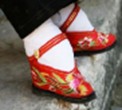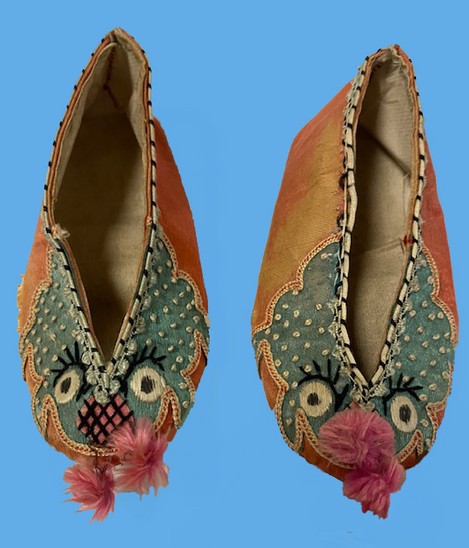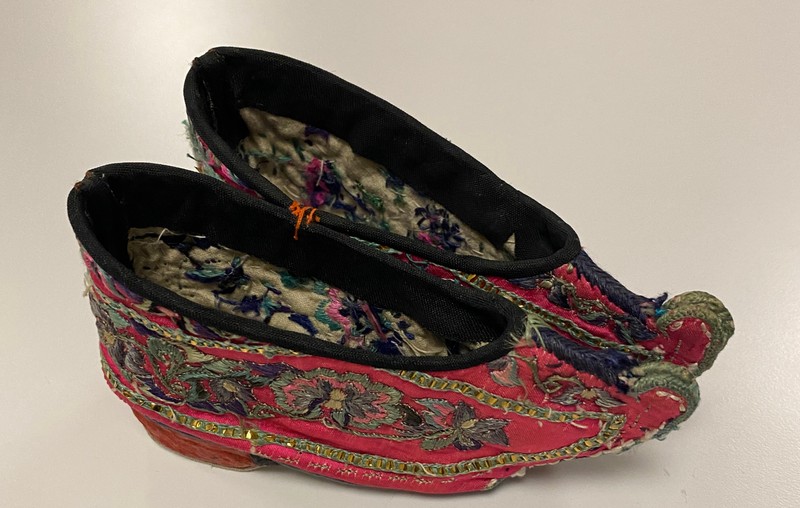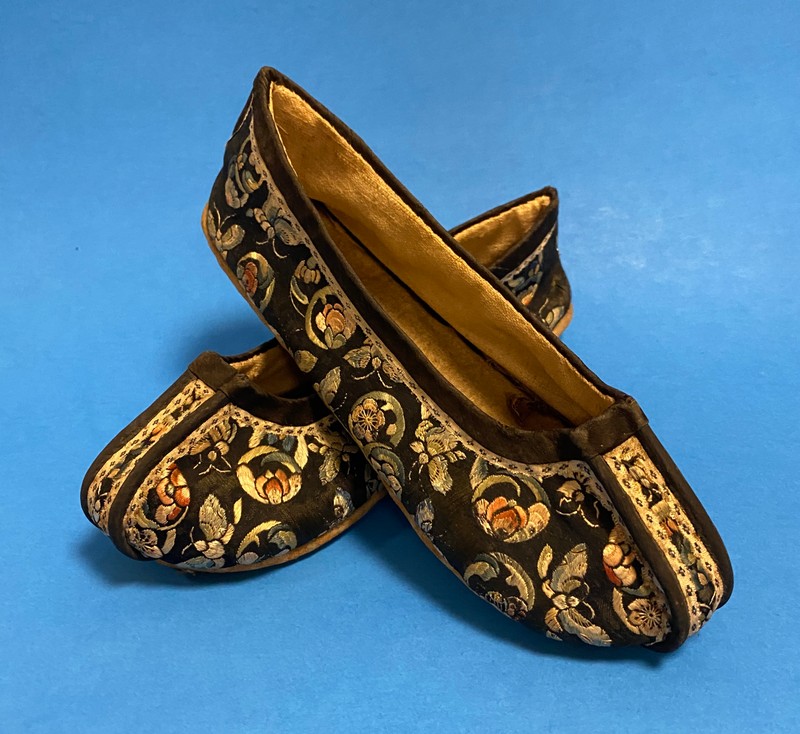Chinese Foot-Binding
Introduction
Text-to-speech Audio
Foot-binding was the custom of tightly binding the feet of very young girls to change the foot size and shape. Her “golden lilies” were believed to make her more attractive to a wealthy husband...
Foot-binding is said to have been inspired by a 10th century court dancer named Yao Niang who bound her feet into the shape of a crescent moon. She impressed Emperor Li Yu by dancing on her toes inside a six-foot golden lotus decorated with ribbons and gemstones. In addition to altering the shape of the foot, the practice produced a particular swaying gait caused by the need to take very short steps. Bound feet in tiny, embroidered slippers were considered attractive...
Gradually, wealthy court ladies began binding their feet, making it a Han status symbol that eventually spread throughout Han society. Foot-binding lasted over a period of more than one thousand years. Some early evidence comes from the tomb of Lady Huang Sheng who died in 1243. Her feet were tiny and misshapen, wrapped in gauze, and placed inside special “lotus shoes..."
It was believed that a small foot represented the height of female virtue, as well as elegance. For families with daughters, foot size became an important bargaining point for marriage. The most desirable bride possessed a three-inch foot, known as a “golden lily.” Four-inch feet—a silver lotus—were acceptable, but five inches or longer were disparaged as “iron lotuses.” The daughters with small feet could marry wealthy men, while those with large feet were likely to work in the fields or at other manual labor...
To turn a natural foot into a golden lily required two to three years of excruciating pain and left a girl in danger of falls or infection throughout her life...
Click on the first photo to view the slideshow of Chinese slippers...
Images
Foot-binding in China lasted for over one thousand years.

Someone had a sense of humor when these slippers were created.

Notice the complexity of the embroidery on these antique slippers.

These slippers may have belonged to a Manchu woman who did not bind her feet.

Imagine a woman undergoing such pain in the name of beautiful feet.

Backstory and Context
Text-to-speech Audio
What was involved in the actual foot-binding? The process started between the ages of five and seven years when a girl’s bones were still flexible. Mothers broke the toes on both feet and pushed them under the sole of the foot, leaving the big toe untouched, and forming a triangle. The arch was bent back on itself. Bindings were wrapped around the feet and changed regularly to prevent infection. Girls were encouraged to walk long distances to break their arches. After two or three years of excruciating pain, the process was complete...
Although it is no longer practiced today, the mystery of female foot-binding and why such torture could have lasted so long is still debated. Theories abound. Many modern scholars attribute the longevity of foot-binding to a combination of social, political, legal, economic, ideological, and cultural forces. It persisted even when several Manchu emperors of the Qing dynasty (1636-1912) banned it. A man's pleasure in a woman's small feet and swaying gait is always in the background of any discussion. Most writers repeat the conventional rationale that it kept a girl from having to toil in the fields and gave her a better life as a “house girl.” Others say the practice is historically rooted in Confucianism's stress on filial duty. Another theory is that the Han Chinese in the Song dynasty (960-1279) used it to differentiate themselves as being culturally superior to their Mongol invaders...
One of the latest theories is based on a 2017 study by Bossen and Gates. They interviewed about 1800 elderly Chinese women, the last generation to have bound feet. Bossen and Gates maintain that few girls ended up enjoying a life of leisure and argue that female child labor was one of the negative results of a patriarchal society. Women with unbound feet worked with men in the fields or on fishing boats while girls and women with bound feet sat still at home embroidering, making yarn, weaving cloth, and producing other goods for income like mats, shoes, and fishing nets. The researchers found that foot-binding declined in every region they studied as soon as manufactured cloth and imports became available, thus undercutting the economic value of handwork...
Some cultural historians speculate that women bonded through this shared experience. Wang Ping in Aching for Beauty found an example of this in a secret language called nu shu (women's writing.) Women wrote messages on nu shu fans or embroidered letters on handkerchiefs complaining about the suffering caused by the male-dominated society. This system of communication was used by women for several centuries in a small rural area of Hunan Province. This little-known history of nu shu was described by Lisa See in Snow Flower and the Secret Fan, a novel that illustrates the complex support system the secret language provided to these foot-bound women in the 1800s...
Few practices have garnered as much attention in women’s history as the subject of Chinese foot-binding. Paradoxically, it maimed the feet of millions of young girls, yet it lasted one thousand years. It often caused death, yet men were thought to find it attractive. It was honored for centuries, yet the practice became a source of ridicule in modern times. The debate reached a high point in the late 19th and early 20th centuries as Chinese literati, missionaries, and reformers led ideological campaigns against it. At the same time, the agricultural tradition was losing ground to jobs for women in the textile factories in the cities. These jobs required natural feet. Finally in 1912, the Nationalist government, followed by the Communists in 1949, made foot-binding illegal, by which time it had largely disappeared...
Cite This Entry
STW on behalf of Assistance League of Long Beach. "Chinese Foot-Binding." Clio: Your Guide to History. January 2, 2024. Accessed March 30, 2025. https://theclio.com/entry/171765/tour/8
Sources
Bossen, Laurel, and Gates, Hill. “Bound Feet, Young Hands: Tracking the Demise of Footbinding in Village China." Stanford University Press. 2017
Foreman, Amanda. “Why Footbinding Persisted in China for a Millennium.” Smithsonian Magazine. February 2015. https://www.smithsonianmag.com/history/why-footbinding-persisted-china-millennium-180953971/ Accessed October 10, 2023
Ping, Wang. Aching for Beauty: Footbinding in China. University of Minnesota Press. 2000. Anchor Books, a Division of Random House, Inc. New York. 2002
Asian Art Collection 74.48
Asian Art Collection 74.47
Howard Collection 74.40
Screenshot 2023-10-19

